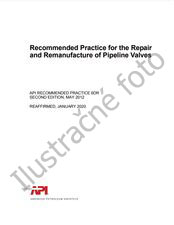Potrebujeme váš súhlas na využitie jednotlivých dát, aby sa vám okrem iného mohli ukazovať informácie týkajúce sa vašich záujmov. Súhlas udelíte kliknutím na tlačidlo „OK“.

API REPORT 86-45-ed.1987
Rheological Characterization of Fracturing Fluids
NORMA vydaná dňa 1.1.1987
| Dostupnosť | Vypredané |
| Cena | NAOTÁZKU bez DPH |
| NA OTÁZKU |
Informácie o norme:
Označenie normy: API REPORT 86-45-ed.1987
Dátum vydania normy: 1.1.1987
Kód tovaru: NS-1139921
Počet strán: 303
Približná hmotnosť: 940 g (2.07 libier)
Krajina: Americká technická norma
*) Pri tovare, ktorý nie je na sklade a musí sa objednávať u vydavateľa sa budú počítať aj skutočné náklady na dopravné a balné. Ich výšku Vám oznámime na základe vášho odkazu na e-mail info@normservis.sk, resp. na telefónnom čísle + 420 566 621 759.
Anotácia textu normy API REPORT 86-45-ed.1987 :
API REPORT 86-45, 1987 Edition, 1987 - Rheological Characterization of Fracturing Fluids
This is the annual report of our research on the rheology of hydroxypropyl guar gels used in hydraulic fracturing operations. Sponsorship for the work comes from the American Petroleum Institute whose primary mission is to provide standard procedures, tests, and performance criteria for the petroleum industry. For laboratory test procedures to be useful they must satisfy two criteria: (1) on the same samples the results must be reproducible not only for a single researcher but between different laboratories, and (2) the results must provide information that is accurate for predicting and designing field fracturing operations. This year we have established those procedures that result in reproducible steady shear viscosity measurements. Excellent reproducibility is obtained when gels are impingement mixed, kept under shear at all times, and run in a narrow gap Couette cell. These results are discussed in detail. A study conducted in conjunction with an industrial laboratory involved in the API TAC for project 86-45 shows that using these procedures similar viscosity data can be obtained in capillary or rotational viscometers. The effects of temperature and shear history are shown, although further studies are warranted.
Further work has been conducted to identify those chemical factors that cause variability in rheological testing. It was found from a combined NMR and dynamic light scattering study that the titanate crosslinking species is not a single molecule but consists of surface TiOH or TiOR groups on colloidal TiO2 particles. The chemical effects that control the stability of the titanate colloids are shown and the sensitivity of HPG gel rheology to salt, pH, and titanate type is explained. The effects of salt on the interactions of HPG polymer chains in solution have been studied using steady and dynamic rheological measurements on HPG solutions. The results show a decrease in solution viscosity with KCl, but an increase in viscosity for high concentrations of NaCl.
A model to predict the viscosity of HPG gels from properties of the gel particles in solution is discussed. The theoretical model is evaluated using covalently polymerized polyacrylamide gels as model systems and is not found to accurately predict the observed viscosity. Data are presented showing the similarity between HPG gel behavior and the rheology of thickeners used in the coatings industry consisting of individually crosslinked gel particles.
The report is presented in the following sequence. Section I is the introduction. In Section II the key results of this years research are summarized. In Section III a brief description of equipment and sample preparation is presented. This section is a repetition of material presented in previous API annual reports [1,2,3] but is included here so that this report is self-contained and a reader does not need access to previous reports. In Section IV the results of rheological measurements are presented. First a brief discussion of steady shear and dynamic oscillatory shear measurements is presented. Again this repeats material presented in previous reports but is included for the sake of completeness. Second the results of a comparative study of HPG gel viscosity in capillary and rotational instruments with controlled shear and temperature histories are shown. Experiments on the rheology of 0.96 wt% HPG gels are presented at the end of Section IV. In Section V those chemical factors that influence HPG viscosity are discussed. These include metal-ion chemistry and polymer-backbone chemistry. In Section VI a model of gel viscosity is presented based on the forces required to move elastic particles past one another. The model is tested against data from some model gels. Finally in Section VII suggestions for future work are presented.
Odporúčame:
Aktualizácia technických noriem
Chcete mať istotu, že používate len platné technické normy?
Ponúkame Vám riešenie, ktoré Vám zaistí mesačný prehľad o aktuálnosti noriem, ktoré používate.
Chcete vedieť viac informácií ? Pozrite sa na túto stránku.



 Cookies
Cookies
